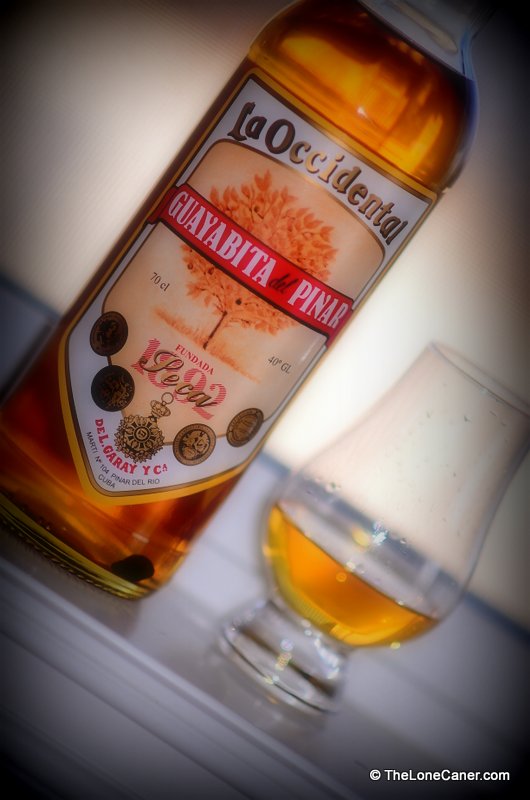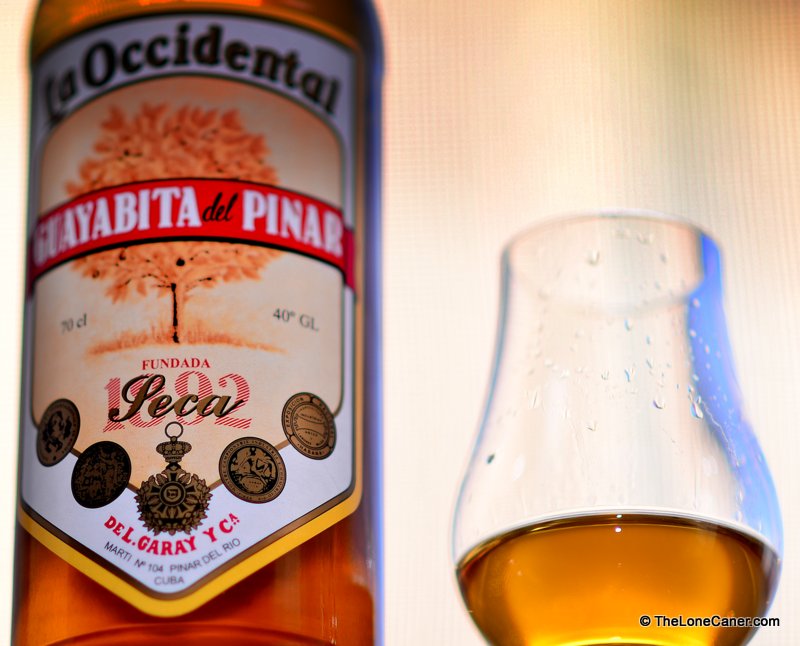Not quite a rum, but close to a spiced or flavoured agricole, and a delicious drink for all that. Big hat-tip to Tony for this one and all the others.
For those who believe Cuba makes only rums, here’s a flavoured spirit close to being one without actually stating it is. It defies easy categorization, which is perhaps why it doesn’t, even on the label, say anything about what it supposedly is (a rum with additives for taste). The issue may be its source, which is variously noted as being either a cane spirit or a guava-based distillate (it’s actually a bit of both). Like the Thai Mekhong, Czech Tuzemak or Austrian Stroh, it’s close to meeting all the requirements, but isn’t, quite. Which doesn’t make it a bad drink, just an intriguing one, and for the purposes of this review, I’ll call it a rum, ‘cause, you know, what the hell. It’s kissing close, and I’m not a total purist in these matters.
What distinguished this product from the Pinar del Rio province in western Cuba to me, was its overall profile. The hay-blonde spirit immediately gave off scents of herbal lemon grass and white guavas, sugar cane peel torn off the stalk with the teeth. Sweet, soft, almost thick, and vaguely perfumed – and none of this was in any way cloying or reeking of an overenthusiastic blender’s machismo either, just harmoniously balanced. To say I was startled is an understatement. Tony (he of the famous 151 proof rumballs) brought this back from Cuba – on a whim, I suspect, just because it looked so different – didn’t know much about it, but having opened it, he loved it and brought it over for us to check out in more detail.
The body and palate were a bit heated (the liquor was 40%, so some spiciness could be expected); what really was fine about it was the mouthfeel, almost silky, decently smooth and very easygoing. One could not get away from the guavas and the sweetness of almost-ripe, fleshy fruit (pears, not peaches), and here again I must stress how well put together the overall product was – there was no real excess sugar or flavoured overkill here, the way you would find in a liqueur, just a delicate balance between competing tastes of nuts, white toblerone, a flirt of vanilla and maybe some more of that raw sugar cane sap. Finish was gentle and medium long – I got less from the aromas than a lingering taste on the tongue, another thing I quite liked.
The outfit that makes this spirit – Sociedad L. Garay y Compañía – has been in operation since 1892, though I was unable to find out how it weathered the Cuban revolution. It seems to run on a semi-privatized basis these days. From what I was able to gather on the various Spanish-language websites I visited, the spirit is made by mixing a large quantity of the macerated guavas with a cane-derived alcoholic base, and the resultant mixture allowed to marry for about a month before being drawn off and aged in oak barrels for a further three months (for the dry “seca” version…two months is considered good enough for the sweet “dulce”).
So an aged product it is not. But you know, some time back I wrote a positive review of the Hawaiian Kōloa rum which had not been aged at all yet still presented itself well as a rum, and Nine Leaves out of Japan does something similar with their “Clear” rum. This little-known almost-rum from Cuba, flavoured and sweet as it is, is a pleasant sipping product to have after dinner (or before it), something to savour with a nice tropical sundown. Don’t look for massive complexity – it’s not that kind of drink – but just enjoy it without fanfare, over ice, and share generously with your friends if that’s their thing, making sure you explain its origin and source materials before they ask the inevitable. Me, I see this as a farmer’s rum, a country rum, similar to backdam hooch my friends and I used to distil out of rice and sugar in the old days, and flavour with whatever fruits were on hand. The Seca reviewed here is made much more professionally than what we did, but the principle remains the same.
And if you haven’t been aware of it before, well, it’s so damned cheap in Cuba that you can’t go wrong with dropping five bucks and at least trying it. Everyone’s heard about Havana Club, Santiago de Cuba and the other big brands out of the island…here’s one it’s worth your while to check out, even if you, like me, may be a bit amused, bemused and confused on the question of whether it’s a rum at all.
(#159. 79/100)

